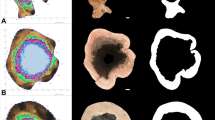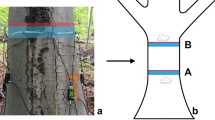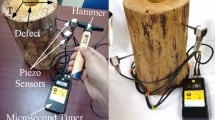Abstract
Key message
Sonic tomography can be used to examine reductions in the load-bearing capacity of tree parts with internal defects, but the limitations of sonic tomography and mathematical methods must be considered.
Abstract
The measurement and assessment of internal defects is an important aspect of tree risk assessment. Although there are several methods for estimating the reduced load-bearing capacity of trees with internal defects, the advancement of these methods has not kept pace with improvements to methods used to measure the internal condition of trees, such as sonic tomography. In this study, the percent reduction to the section modulus, ZLOSS (%), caused by internal defects was estimated using 51 sonic tomograms collected from three tree species, and the accuracy of measurements was assessed using the destructively measured internal condition of the corresponding cross sections. In tomograms, there was a repeated underestimation of the percent total damaged area, AD (%), and a repeated overestimation of the offset distance between the centroid of the trunk and the centroid of the largest damaged part, LO (m). As a result, ZLOSS determined using tomograms was mostly less, in absolute terms, than that determined from destructive measurements. However, the accuracy of these estimates improved when using colors associated with intermediate sonic velocities to select damaged parts in tomograms, in addition to the colors explicitly associated with the slowest sonic velocities. Among seven mathematical methods used to estimate ZLOSS, those accounting for LO were more accurate than others neglecting it. In particular, a numerical method incorporating greater geometric detail, called zloss, gave estimates that were consistently better than six other analytical methods.





Similar content being viewed by others
References
Arciniegas A, Prieto F, Brancheriau L, Lasaygues P (2014) Literature review of acoustic and ultrasonic tomography in standing trees. Trees 28:1559–1567
Brazee NJ, Marra RE, Gocke L, Van Wassenaer P (2011) Non-destructive assessment of internal decay in three hardwood species of northeastern North America using sonic and electrical impedance tomography. Forestry 84:33–39
Burcham DC (2017) zloss. GitHub, version 1.1. https://github.com/danielburcham/zloss. Accessed 29 Nov 2017
Ciftci C, Kane B, Brena SF, Arwade SR (2014) Loss in moment capacity of tree stems induced by decay. Trees 28:517–529
Coder KD (1989) Should or shouldn’t you fill tree hollows? Grounds Maint 24:68–70 (72–73, 100)
Crawford SB, Kosinski AS, Lin HM, Williamson JM, Barnhart HX (2007) Computer programs for the concordance correlation coefficient. Comput Methods Progr Biomed 88:62–74
Deflorio G, Fink S, Schwarze FWMR (2008) Detection of incipient decay in tree stems with sonic tomography after wounding and fungal inoculation. Wood Sci Technol 42:117–132
Ennos AR (2012) Solid biomechanics. Princeton University Press, Princeton
Gilbert EA, Smiley ET (2004) Picus sonic tomography for the quantification of decay in white oak (Quercus alba) and hickory (Carya spp.). J Arboric 30:277–281
Gilbert GS, Ballesteros JO, Barrios-Rodriguez CA, Bonadies EF, Cedeno-Sanchez ML, Fossatti-Caballero NJ, Trejos-Rodriguez MM, Perez-Suniga JM, Holub-Young KS, Henn LAW, Thompson JB, Garcia-Lopez CG, Romo AC, Johnston DC, Barrick PP, Jordan FA, Hershcovich S, Russo N, Sanchez JD, Fabrega JP, Lumpkin R, McWilliams HA, Chester KN, Burgos AC, Wong EB, Diab JH, Renteria SA, Harrower JT, Hooton DA, Glenn TC, Faircloth BC, Hubbell SP (2016) Use of sonic tomography to detect and quantify wood decay in living trees. Appl Plant Sci 4:1–13
Gocke L (2017) PiCUS Sonic Tomograph: Software Manual Q74. Argus Electronic GmbH, Rostock, Germany
Gruber F (2008) Reply to the response of Claus Mattheck and Klaus Bethge to my criticisms on untenable VTA-failure criteria. Who is right and who is wrong? Arboric J 31:277–296
Johnstone D, Moore G, Tausz M, Nicolas M (2010) The measurement of wood decay in landscape trees. Arboric Urban For 36:121–127
Kane B (2014) Determining parameters related to the likelihood of failure of red oak (Quercus rubra L.) from winching tests. Trees 28:1667–1677
Kane B, Ryan HDP (2004) The accuracy of formulas used to assess strength loss due to decay in trees. J Arboric 30:347–356
Kane B, Ryan HDP, Bloniarz DV (2001) Comparing formulae that assess strength loss due to decay in trees. J Arboric 27:78–87
Koizumi A, Hirai T (2006) Evaluation of the section modulus for tree-stem cross sections of irregular shape. J Wood Sci 52:213–219
Kutner MH, Nachtsheim CJ, Neter J (2004) Applied linear regression models. McGraw-Hill Irwin, Boston
Legland D (2015) matGeom. GitHub, https://github.com/mattools/matGeom/
Li L, Wang X, Wang L, Allison RB (2012) Acoustic tomography in relation to 2D ultrasonic velocity and hardness mappings. Wood Sci Technol 46:551–561
Liang S, Fu F (2012) Strength loss and hazard assessment of Euphrates poplar using stress wave tomography. Wood Fiber Sci 44:1–9
Liang S, Wang X, Wiedenbeck J, Cai Z, Fu F (2007) Evaluation of acoustic tomography for tree decay detection. In: 15th international symposium on nondestructive testing of Wood Duluth, MN, US, pp 49–54
Marasinghe MG, Kennedy WJ (2008) SAS for data analysis: intermediate statistical methods. In: Chambers J, Hardle W, Hand D (eds) Statistics and computing. Springer, New York, p 557
Marra RE, Brazee N, Fraver S (2018) Estimating carbon loss due to internal decay in living trees using tomography: implications for forest carbon budgets. Environ Res Lett 13:105004
Niklas KJ (1992) Plant biomechanics: an engineering approach to plant form and function. University of Chicago Press, Chicago
Ostrovsky R, Kobza M, Gazo J (2017) Extensively damaged trees tested with acoustic tomography considering tree stability in urban greenery. Trees 31:1015–1023
Rabe C, Ferner D, Fink S, Schwarze FWMR (2004) Detection of decay in trees with stress waves and interpretation of acoustic tomograms. Arboric J 28:3–19
Rust S (2017) Accuracy and reproducibility of acoustic tomography significantly increase with precision of sensor position. J For Landsc Res 1:1–6
Smiley ET, Fraedrich BR (1992) Determining strength loss from decay. J Arboric 18:201–204
Smiley ET, Matheny N, Lilly S (2011) Tree risk assessment. International Society of Arboriculture, Champaign
Steger C (1996) On the calculation of moments of polygons. Technical University of Munich, FGBV-96-04, Munich, pp 1–14
Wagener WW (1963) Judging hazard from native trees in California recreational areas: a guide for professional foresters. Pacific Southwest Forest and Range Experiment Station, Forest Service, US Department of Agriculture, PSW-P1, Berkeley, pp 1–29
Wang X, Allison RB (2008) Decay detection in red oak trees using a combination of visual inspection, acoustic testing, and resistance microdrilling. Arboric Urban For 34:1–4
Wang X, Allison RB, Wang L, Ross RJ (2007) Acoustic tomography for decay detection in red oak trees. Forest Products Laboratory, Forest Service, US Department of Agriculture, FPL-RP-642, Madison, pp 1–7
Wang X, Wiedenbeck J, Liang S (2009) Acoustic tomography for decay detection in black cherry trees. Wood Fiber Sci 41:127–137
Funding
Funding for tomography and destructive measurements was provided by the National Science Foundation EArly-Concept Grants for Exploratory Research (EAGER) Program (Grant #DEB-1346258). Additional funding for numerical analysis was provided by the National Parks Board, Singapore.
Author information
Authors and Affiliations
Corresponding author
Ethics declarations
Conflict of interest
The authors declare that they have no conflict of interest.
Additional information
Communicated by Fourcaud.
Publisher’s Note
Springer Nature remains neutral with regard to jurisdictional claims in published maps and institutional affiliations.
Rights and permissions
About this article
Cite this article
Burcham, D.C., Brazee, N.J., Marra, R.E. et al. Can sonic tomography predict loss in load-bearing capacity for trees with internal defects? A comparison of sonic tomograms with destructive measurements. Trees 33, 681–695 (2019). https://doi.org/10.1007/s00468-018-01808-z
Received:
Accepted:
Published:
Issue Date:
DOI: https://doi.org/10.1007/s00468-018-01808-z




